New Delhi: At Delhi’s Connaught Place and Anand Vihar, the faint hum of powerful fans indicates the presence of smog towers — large-scale devices intended to reduce the amount of particulate matter in the air as winter approaches and air quality index reaches ‘severe’ or ‘hazardous’ levels.
Smog towers have, off late, been touted as a solution to the city’s mounting air pollution problem. Last year, the Supreme Court gave the central government a 10-month deadline to install two towers in the city, in compliance with a 2019 order.
In August, Delhi Chief Minister Arvind Kejriwal inaugurated the first of these towers in CP, which became functional on 22 September.
Bhupendra Yadav, Union Minister of Environment, Forest, and Climate Change, inaugurated the second one on 7 September in Anand Vihar, which has been functional ever since.
Delhi’s Environment Minister Gopal Rai has said the towers — which cost Rs 20 crore each — filter out 80 per cent of particulate matter (PM) in the air. Experts, however, say these claims should not be taken at the face value.
ThePrint explains how these smog towers function, whether they help in controlling pollution, and what experts have to say.
The smog towers
The two smog towers in the national capital are identical in design and shape. Each tower is 24 meters in height with 5,000 high-efficiency particulate air (HEPA) filters through which air is filtered in. It is designed to process 1,000 cubic meters of air per second.
The structure sucks in air from the top, runs it through the filters, and then pushes it out from the bottom with the help of 40 large fans. Designed by the University of Minnesota, the tower was modified by IIT-Bombay and IIT-Delhi to fit the Indian weather. It has eight sensors — two on each side of the square structure — to track pollution levels at the inlet and outlet.
The IITs are studying the tower to monitor its effectiveness, which involves measuring pollution levels at various distances from the tower.
“Unlike towers in China, which target residential areas, we want to see what effect the towers will have at a pedestrian level on the ground,” said a member of the team from IIT-Bombay, who did not wish to be named.
According to Anwar Ali Khan, a senior environmental engineer with the Delhi Pollution Control Committee (DPCC), who is in charge of the smog tower in Connaught Place, the filters will need to be changed every three to four months, and operation and maintenance costs will amount to Rs 1.2 crore a year. The tower functions for 8 to 12 hours a day for now, and consumes an average of 1,150 kWh (kilowatt-hour) of electricity a day.
“The number of hours it should run will change depending on the recommendations of the IIT teams,” Khan said.
Control rooms attached to the tower have screens that monitor the level of pollution at inflow and outflow, and can control the speed of the fans through which the air is pushed out.
Also read: Smog towers for Delhi pollution are like paracetamol for dengue — won’t cure real disease
Do smog towers help fight air pollution?
The idea of smog towers as a viable solution for air pollution was popularised when China built a 100-metre tall tower in Xian city. Despite the publicity the tower attracted, there hasn’t been any data to support the fact that the tower, and not other measures, helped reduce pollution levels.
Air is dynamic in nature and doesn’t have boundaries, which means it flows in all directions. PM 2.5 and PM 10 particles are well mixed in air, and a smog tower cannot control free flowing air. As researchers at Urban Emissions, a research and advocay firm focusing on air pollution, put it, “With no boundaries, it is unscientific to assume that one can trap air, clean it, and release into the same atmosphere simultaneously.”
Karthik Ganesan, Fellow and Director, Research Coordination at the Council on Energy, Environment and Water (CEEW), said, “The claim that the smog tower has led to an 80 percent reduction in pollution isn’t exactly accurate. That difference seems to be just between the inlet and the outlet, which any purifier will show. What we need to see is how effective it is 20 feet away, or 1 kilometre away.”
A study by CEEW found that open fires (including stubble burning) accounted for around 30 per cent of air pollution in Delhi from October to November 2020. Household emissions (cooking etc) accounted for 24 per cent of pollution from November to December, and 36 per cent from December to January 2021.
“You can’t vacuum out pollution from the air. Scientifically speaking, there is no basis for this. The easiest and most effective way is to reduce air pollution at the source,” Bhargav Krishna, a fellow at the Centre for Policy Research, told ThePrint.
“There are a number of things that can be done. Delhi is not in isolation, and the pollution problem requires action from Punjab to Bihar, across the Indo-Gangetic plain. Managing construction waste, enforcing rules on thermal power plants, and reducing industrial emissions at the source are some examples,” he added.
Ganesan said it was a matter of concern that other cities such as Chandigarh and Noida are considering setting up smog towers of their own, given the lack of scientific evidence and no judicial directive, as in the case of Delhi.
“These towers are a waste of money, and these resources are better used in addressing the source of pollution instead,” he said.
(Edited by Neha Mahajan)
Also read: Delhi to get more smog towers to fight pollution, but experts say it will be waste of money






